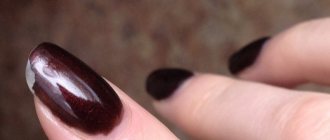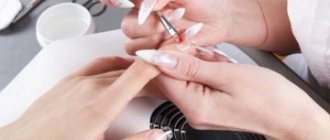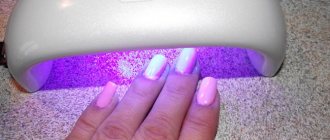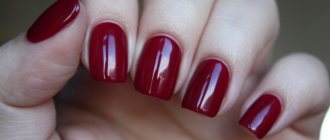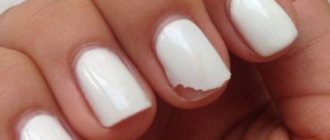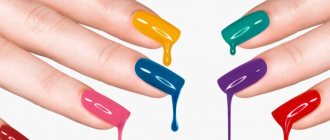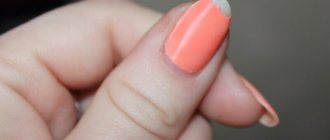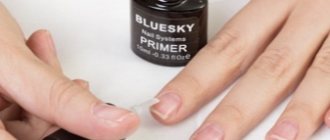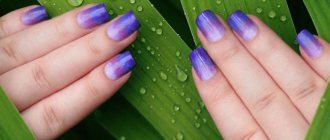Frequent reasons why gel polish on nails cracks are skimping on the quality of the products used and violation of manicure technique (thin or thick layers, etc.). A low-power or old drying lamp, an unerased sticky layer, or air bubbles in the top can also cause a defect.
A crack on the free edge occurs at a large length, if no reinforcement was done, or from mechanical impact. It can form when working in water and with household chemicals with bare hands. Often the problem appears if you do a manicure during menstruation, during pregnancy or illness, or while taking antibiotics. Strengthening gels, fiberglass, silk, acrylic powder mixed with the base will help to cope with the crack.
Popular mistakes why gel polish on nails cracks
Explanations for why gel polish on nails cracks can be found in the following:
- violations at the stage of preparation for coating;
- its layers are too thin or excessively thick;
- the polymerization lamp is weak or has already exhausted its service life and therefore requires replacement;
- leaving or insufficient removal of stickiness from the base, flower bed or first layer of top;
- using a finish that has created bubbles;
- low-quality manicure products (gel polishes, bases, tops).
Cracks can form only at the tips of the nails due to their natural mobility, the abundance or too thin layer of coating, or poor preparation for its application. They happen in other areas too.
Errors in technology
Defects appear due to errors in the coating technique and at the preparatory stage:
- the stratum corneum of the cuticle is not completely removed;
- after a hygienic “wet” manicure, the nails are poorly dried from water;
- their surfaces are unevenly sanded with buff;
- no degreaser was used, cream was applied to the hands on the day before the manicure;
- the nails are hard, but a hard base product is used for them, and all this together literally tears apart the rubber gel polish;
- the base, flower bed and top do not match each other.
These errors often cause coating detachments. But first it may crack.
Crack due to thick or thin layer
A crack can form due to an excessively thick layer of coating, since its upper part shrinks when drying, and the lower part stretches. Tension leads to ruptures on the surface.
A thin layer of flower bed can also crack. This happens with single-phase gel polishes or well-pigmented products, which can be saved without compromising the tone of the nails. But ultimately, the base from the inside causes stress on the flower bed, and it cracks.
Lamp problems
The coating layers will be elastic, but durable only when using a high-quality lamp, that is, with a power of 36 W or more. Weaker devices may not polymerize the base, flower bed or top well enough, leaving undried areas on the sides of the nails. This is the cause of cracks.
It is important that the light elements work well even at the specified power. If the lamp has been used for a long time, they may look the same in appearance, but the radiation they produce is weak. Hence the poorly dried coating and cracks on it within a couple of days.
Remaining sticky top coat
Sometimes it is not the flower bed that cracks, but the top, and this can be caused by:
- The presence of residual stickiness on the gel polish underneath. After the flower bed has dried, it must be removed with a cleaner. But some people think that stickiness will help the layers of products adhere more firmly. In fact, this causes the top on the gel polish to crack, since it is not possible to apply it evenly.
- The presence of a sticky layer on the finishing product itself. The top is sometimes applied in 2 layers, for example, when attaching sliders or other decor. And for the same reason as in the previous case, the sticky layer is not removed. And it creates additional tension for the top coating itself, as a result it cracks.
Sometimes it is discovered that the gel polish under the top coat is cracking, and the reason may be the residual stickiness of the base product. It also needs to be removed with a cleaner or special wipes.
Bubbles in the topcoat
Air bubbles may be detected in the top coat even at the application stage. They are formed as a result of improper storage, expiration of the product, but also when it is actively mixed or shaken before use. During polymerization, the bubbles do not disappear, but make the surface uneven. Because of the air in them, the destruction of the coating begins, and numerous small cracks appear.
Poor quality materials
Cheap manicure products, which beginner nail artists often like to buy, are not durable enough to last 2-3 weeks. More often, cracking results from the use of low-quality gel polishes. Even if they have beautiful colors, they polymerize well and quickly, the lack of any components in the composition leads to damage to the coating. And they appear even with a very careful attitude to manicure.
The base and finish should also be of good quality. If they are not strong and elastic enough, even expensive gel polish will not save your nail design.
If only on the tips of the nails
A defect occurs only at the tips of the nails for several reasons:
- There was too little material in this area. This happens when you don’t know how to level with a base, but you don’t want your nails to look “buns.” And the thin coating is easily damaged, especially at the tips, which are most susceptible to mechanical stress.
- The nails were poorly prepared. Usually, due to lack of experience when grinding and degreasing, more attention is paid to the areas near the proximal and lateral ridges. And the ends remain damp, or the shine is poorly removed from them with a buff.
- The abundance of material is closer to the ends. The tips are more mobile than the main part of the nails, so the thick layer of coating is exposed to quite active effects. But the gel polish itself overloads this area. Cracks are formed as a result of the mutual influence of the material and the flexible free edge of the plate.
Unobvious reasons why gel polish cracked
The reasons why the gel polish cracked may not be in the quality or methods of the products or manicure liquids used, but purely external:
- working with your hands without gloves, which requires effort and puts stress on your nails;
- household chemicals and cosmetics;
- poor condition of the plates (dryness and thinning, fungus, onycholysis);
- frequent and prolonged exposure of fingers to water;
- hormonal changes;
- general diseases.
External factors
Among the external factors that provoke cracking of the coating, experienced craftsmen name:
- Mechanical impact on nails. Some lovers of professional manicure are confident that it will last no matter what. And, using their nails, they peel wallpaper from the walls during repairs, open cans or scrape burnt pans. Such careless handling of the coating, although more durable than regular varnish, leads to its cracking.
- Household and other chemicals. Substances contained in liquids for washing dishes and wiping polished furniture can greatly dry out the coating. One of the consequences of this is cracking, but also detachments.
- Cosmetics. Oddly enough, nourishing and moisturizing creams and scrubs can affect the integrity of the coating. A problem is more likely if the products contain abrasive particles or a high concentration of acids.
Nail condition
You can only do a manicure with gel polish on healthy nails, but many people forget about this, as a result they quickly get cracks in the coating due to:
- Uneven surfaces. Lumps and depressions may be the result of rough exposure to manicure tools or vitamin deficiency. But they will interfere with the quality of adhesion of the material to the surface. As a result, the coating cracks.
- Diseases. The fungus makes the nails fragile; already under the coating, plate particles can crumble and fall off. The resulting voids lead to sagging of the gel polish in these areas and the appearance of cracks nearby. Onycholysis, that is, separation of part of the nail from the bed, makes them more mobile not only on the free edge. Vibrations of the plates under the material lead to its damage in the form of cracks.
- Thinning. If you apply gel polish continuously without monitoring the condition of your nails, they can quickly weaken and become fragile. The coating will hold up worse, but will not necessarily fall off immediately, but may crack.
Water influence
Exposure to water can also lead to the appearance of cracks in the polymerized coating, although the liquid cannot penetrate into it. The defect occurs more often in those who:
- accustomed to or forced to frequently wash and disinfect hands;
- does washing dishes and other household chores without gloves;
- With frequent contact with water, she also uses detergents, including those with abrasive particles.
Soaps, gels for dishes, baths, and floors contain alkali, which dries out the coating. Water in combination with detergents has an even more aggressive effect on gel polish. In addition, the liquid causes the nails under the coating to swell, stretching it.
For those who have “problem hands” and gel polish does not adhere well to the nails due to natural reasons, nail experts recommend not doing household chores or visiting the bathhouse for 2-3 hours after performing a manicure.
Other
Sometimes the reason for the appearance of cracks in gel polish should not be sought in manicure products and technical errors, but it becomes:
- The client is taking antibiotics. Medicines affect the body as a whole and the condition of the nail plates, although the latter is invisible to the naked eye. But while taking antibiotics, wearing a manicure can cause problems - the appearance of detachments or cracks in the coating.
- Hormonal changes. Gel polish often cracks in young girls with an unformed balance of substances, or in women before menopause. Manicures done during or before your period can also crack. During pregnancy and for several months after childbirth, defects often appear on the coating, even if it was previously worn well and for a long time.
Oral contraceptives taken by a woman can also cause cracks. This category of reasons for their occurrence includes diseases in which the balance of hormones is disrupted. These are, for example, diabetes or thyroid pathologies, in which the hands are often wet.
- Other diseases, poor general health. Even a common cold can affect the quality of your manicure. The same thing happens with pathologies of the digestive and cardiovascular organs. Therefore, you should wait for recovery, only then do the procedure.
Causes of premature detachment of extended nails
Sometimes the answer to the question of how long nail extensions last can be completely ambiguous. This can be purely individual. If you suddenly notice that peeling has appeared on your nails or their shine has completely faded, and very little time has passed since a fresh overlay, then sound the alarm and immediately visit your master.
Causes:
- a mistake made by the master because he incorrectly calculated the architecture of the applied nail;
- the tip is sanded unevenly or the coating is applied very carelessly;
- inflammation of the skin, due to which the applied plate becomes foreign, and a process of rejection occurs;
- fungal disease or the presence of other body disorders;
- medications that interact poorly with foreign bodies;
- your own manicure, which was performed before the extension procedure and was not removed properly;
- hormonal status (nail extensions cannot be done during the menstrual cycle, pregnancy and the early postpartum period).
Why does shellac crack on natural or extended nails?
Shellac on your own and extended nails cracks for various reasons, since the manicure technique and materials are different in both cases; in the first, defects more often arise due to:
- problems with nails (thin, brittle, dry, uneven);
- poor-quality base, flower bed, top, other means used in the process;
- mixing two or more gel polishes to obtain a new shade;
- improper application, insufficient drying in the lamp;
- natural hormonal changes or caused by diseases;
- taking medications.
Cracks can form if the base is chosen incorrectly. If your nails are flexible and this product is hard, a problem is likely to occur. The solution is to apply a soft base base, and only then apply a product from the strong category.
When building up, shellac quickly cracks for the following reasons:
- errors in the procedure technique (installation of extension film crookedly, etc.);
- incorrectly chosen nail shape (not anatomical or overloading the free edge with material);
- an abundance of gel or its excessive savings;
- mechanical impact, because long nails are more fragile than short ones.
In both cases, it is necessary to select the appropriate material, that is, a base for natural nails and a gel for extension if you want to increase the length. Sometimes it’s worth changing one product to another, and the manicure will last well until correction.
Perfect manicure
To get perfectly extended plates, you need to train your hand at all stages of modeling. Let's consider what an ideal artificial nail plate with acrylic or gel nail extensions should be like.
General form
The extended nail must have clear, even contours, the same length and shape, as well as shine. The shape of the nails is selected according to the configuration of the natural nail plate and fingers.
Length of the extended nail
Its choice should be justified by the length of the plate.
The area near the cuticle, where a new nail bed is born, should have an almost imperceptible, smooth transition from artificial to natural.
The configuration of the transverse C-bend on the inside should match the outside, the arch should be the same on all plates and be fifty percent of the circle.
Thickness
The thickness of the free edge should ideally not exceed 3/4 millimeter in height. This is approximately the thickness of a plastic card. You should definitely check what its shape is, and whether there are any irregularities.
According to plate modeling standards, the thickness of the extended nail should be similar to the thickness of a rolled business card. This is equal to approximately one and a half millimeters, and in the middle this thickness indicator should be thicker, because this is where the stress zone is located.
This indicator should be thicker along the smile line, where damage occurs. The length also depends on the thickness - the longer the plate, the thicker it is.
There are no air bubbles. The shape of the smile is the same on all plates.
The lateral lines smoothly transition from the natural material, receding at a distance into a thin, almost imperceptible hair. The lines on the sides should be straight, parallel to the fingers on all plates.
Modeled plates must be clean and tidy. Residues of gel or acrylic, dust and other foreign materials are unacceptable.
A beautiful manicure is an essential part of well-groomed women's hands.
Whether it’s a design on your nails, false nails, or extensions, it doesn’t matter at all, the main thing is that it brings you joy
Temporary factors for cracked manicure
A cracked manicure can be discovered literally a few hours after the procedure or some time later. Each case has its own reasons.
Immediately after applying the material
If the coating cracks on the first day, this may indicate:
- low quality of the products used;
- poor preparation of nails for applying the material;
- errors in the technique of performing the procedure.
That is, the causes of the problem are rather external, which means they can be quickly eliminated.
On the second day
A problem that appears on the second day after performing a beauty procedure may arise due to:
- poorly chosen time for its implementation, for example, on the eve of menstruation;
- working too actively with your hands without gloves immediately after a manicure;
- attending other procedures where exposure to moisture is expected.
Sometimes poor quality of the material is to blame for the formation of cracks.
Which company is better to choose?
Shellac can crack due to the fact that low-quality material is chosen for the work. Manicurists prefer to work with CND
, they were the first to produce this type of product and still occupy a leading position in its production. In addition, the company provides a 14-day guarantee of impeccable quality of the applied coating.
When choosing shellac from CND, it is important to buy original products. To do this you need to know the following nuances:
- A bottle of coating cannot cost less than 1000 rubles. If you are offered to buy shellac for 200-300 rubles, you should know that this is a Chinese counterfeit. It won't last even four days on your nails;
- The original product is produced in America, there is a corresponding note about this on the bottle;
- Buy products only from trusted suppliers or specialized stores.
It is also very important that all components of the coating are of the same series.
In this case, there will be no “conflict” between them. Shellac manicure has become quite popular recently. And this is no coincidence. It applies quickly enough and lasts a long time. In addition, the color palette allows you to create an unforgettable, vibrant image. Thousands of women are interested in the question of why shellac cracks on nails. There may be several reasons, ranging from the unprofessionalism of the master to low-quality material. If such problems arise, do not immediately refuse the service; try switching to another company’s coating or changing your manicurist.
Cracked gel polish on nails: how to save it if you just started
When the gel polish on your nails is cracked in one place, you can save the appearance by simply repairing it with a top coat. The area is filed down so that the defect is eliminated, but the color remains. The dust should be wiped off with a degreaser and a layer of top coat should be applied to the nail and dried in a lamp.
If the color in an area with a defect had to be cut down to the base, you can cover it with a slider. On top, as in the first case, a finishing agent is applied and polymerized.
What to do if it’s already cracked
If the coating is severely cracked, there is no point in doing anything other than removing it. Due to further nail growth, the defects will increase, becoming more noticeable. Therefore, you should remove the coating at least to the base layer. If there are no cracks on it, use a flower bed and top. In case of defects and on the base, it is also removed, and the coating is completely reapplied.
Why do nails crack under gel polish?
The nail cracks under gel polish also for several reasons:
- the plates are thin and brittle;
- there is a lot of material on them, especially on the free edge;
- there are cuts on the nails with a milling cutter, that is, thinned areas;
- the plates were given the wrong shape (they were too narrow, the required volume was removed at the growth points);
- the coating was performed despite the nail disease, although this should not be done;
- their length is too long, and the strengthening was not carried out;
- mechanical damage was caused during a hygienic manicure or after;
- the coating wears out.
How to restore a cracked nail
A cracked nail can be repaired, no matter where it is damaged, with:
- polygel, biogel, gel-jelly of thick consistency, base with acrylic powder for small cracks;
- acrylic;
- fiberglass;
- silk or fiberglass.
The repair procedure looks like this:
- Remove the old coating, possibly down to the base layer or in such a way that there is no artificial material left on the nail (the crack should be visible).
- The plate is wiped with a degreaser.
- Then a primer is applied and after it dries in air, a thin layer of base product is applied, which is polymerized.
- Using an orange stick, take a portion of the gel and apply it to the place where the crack is located.
- The material is leveled with patting movements, using a flat brush dipped in degreaser and lightly wrung out.
- The material is dried in a lamp.
- If there is a sticky layer on it, remove it.
- The nail needs to be filed to remove excess material.
- Dust is removed with a lint-free cloth and further coating can be applied as usual.
If fiberglass is used, there should be a damp base underneath it. The reinforcing film is separated from the substrate and placed on the crack. And on top you need to apply another layer of base and dry it in a lamp. The nail is strengthened in the same way and the defect is eliminated with fiberglass. But after drying the material, its excess is cut off with scissors. Then you can use liquid camouflage gel.
Watch the video about options for repairing cracked nails:
Infections after nail extensions
When using non-sterile tools for nail extensions, various types of infections may appear that violate the natural integrity of the natural nail. When the gel or acrylic layer on the nail is damaged, a small gap (air gap) appears, which is an ideal environment for the proliferation of pathogenic fungi and microorganisms. If the damaged nail is not freed from the artificial layer, this can lead to negative consequences.
gribok-nogtej-pod-gelevim-nogtem
It is worth remembering that even after high-quality extensions, the nail plate weakens significantly, which increases the risk of infection with many fungi and infections. If you find a damaged nail, it is recommended to go to a salon or remove the artificial layer yourself using a file. Treatment of fungal infections takes a fairly long period of time, which averages 6 months. If you do not consult a doctor in a timely manner, there is a high probability of losing your own nail and damaging the soft tissues of the hands. Manicurists and doctors advise constantly monitoring changes in the color and structure of the nail plate.
Defect prevention measures
To prevent the appearance of cracks in the coating or “living” nail, you should:
- take care of your nail plates, take vitamins to strengthen them;
- avoid damaging them when performing a manicure to avoid cuts and thinning;
- when giving shape, take into account the characteristics of the nails, do not try to narrow them at the cost of cutting off the lateral lines and injuring the growth points;
- It is good to remove the keratinized part of the cuticle;
- try not to allow gel polish to drip onto the skin, as this area can become the beginning of a crack;
- use only high-quality coating products;
- strictly follow the sequence of the procedure;
- do not use a lot of material;
- strengthen with acrylic powder or gel for long lengths;
- apply elastic rubber under a strong base, even with soft nails;
- do not tear off the old coating, but remove it using a special liquid or by carefully cutting it off with a hardware router;
- do housework that involves contact with water and household chemicals, only wearing gloves;
- postpone performing a beauty procedure to another time during menstruation, illness or simply not feeling well;
- adjust your manicure in a timely manner, do not wear it for longer than 2-3 weeks;
- In winter, wear gloves or mittens outside so that the coating is not exposed to additional temperature effects;
- Do not bite your nails or pick at hard surfaces.
In most cases, cracks can be prevented. But you need to have good gel polishes, base, top, carefully prepare your nails for manicure, learn how to do everything correctly. It is worth considering that the gel polish coating, although durable, is also subject to mechanical stress. Therefore, any work should be done with gloved hands.
Reasons depending on surface type
Natural nails
On natural nails, gel polish can also crack.
The following factors contribute to this:
- frequent hand washing;
- changes in hormonal levels during the procedure;
- long-term use of antibiotics;
- low-quality manicure accessories;
- hormonal changes in the body;
- some diseases;
- incorrect application of the gel.
An unhealthy nail plate is a common cause of cracks.
Extended nails
Reasons that can trigger the formation of cracks on extended nails:
- non-compliance with extension techniques;
- incorrect application procedure;
- mechanical damage;
- poor quality material;
- applying a thick or thin layer.
Contact with water and household chemicals also negatively affect the gel on extended nails.
